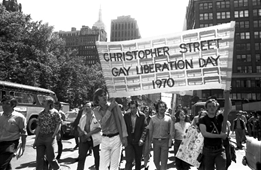Steph Marinelli ’25, Managing Editor
How long must one live in the shadows of fear and doubt, before they too may be graced by the light? How long can one last denying who they are, believing that what society says must define their sense of being? How long can one wait for change? For those of the LGBTQ+ community, the time was now. For they too, deserve to bask in rays of freedom.
And thus, the Gay Rights Movement initiated with the creation of The Society for Human Rights, founded by Henry Gerber, a German immigrant, who served in the United States Army during WWI. However, the inspiration did not come from “the land of the free,” but rather Coblenz, Germany, where he was temporarily stationed before his return to the states in 1923. In comparing the rather progressive and accepting Scientific-Humanitarian Committee, a “homosexual emancipation group” which influenced his later actions, to the “criminalized ideals” that fell victim to sectionalization in the U.S., he decided to pursue true freedom for all through reference of the Declaration of Independence’s law and order ideals and the “right to pursue happiness.” Thus, The Society for Human Rights was started in 1924, and is credited for creating the first ever “gay interest newsletter” titled Friendship and Freedom which only lasted until 1925, due to fear-based avoidance and rage-filled hate by those against such actions. Furthermore, the group’s vivacity soon dwindled following multiple police raids and arrests influenced by the country’s bias (also, in 1925). Despite this, the Henry Gerber House, which honors the boarding house he lived in in Chicago, Illinois, still holds great value to those within the LGBTQ+ today and is a landmark that represents courage in the face of extreme adversity.
Despite the sense of liberation to come from Germany through Henry’s ideals, the Nazi invasion in 1933 completely halted any such progress made. 1871 marks the year in which homosexuality was made illegal within this country, and the introduction of the Pink Triangle more accurately depicts it. This is a direct result of Nazi revision to such a law, in which any action as little as looking at another man could result in arrest and relocation to a concentration camp. As an enforcement with certain ideals for a “perfect society,” those of the LBGTQ+ community were what scholars considered “the lowest of the low in the camp hierarchy,” which explains the triangles inversion. Hitler held such animosity as homosexual couples’ inability to have children disrupted the expansion of his “Aryan race.” However, this coloring only applied to the men. Lesbians were believed to wear a black inverted triangle, along with prostitutes, and were considered the “asocial” group. While there is no accurate estimation of how many died, there is knowledge of what these individuals where subjected to, including: segregation from other prisoners (for fear of catching their “disease”), castration, medical test subjection (more specifically, for Typhus Fever and the “Homosexuality”) and a demand for sexual favors by Kapos, or prisoners with elevated status. Following WWII’s conclusion in 1945, Nazi law remained evident until 1969 with West Germany’s “decriminalization of gay relationships among men over 21.” However, expressions of anti-sodomy were far from over.
The Mattachine Foundation of Los Angeles, Californiaadded fuel to the fire beginning in 1950 during what was considered the Homophile Years (this term was used in placed of “homosexual” and is seen as one that can find fewer ways to use in a derogatory manner). Official creator, Harry Hay, along with other members, took their experience within the Communist Party and applied a similar structure to the formation of “one of the first gay rights groups.” Spreading across several states and regions, participants were kept informed through individual newsletters and papers, but mainly The Mattachine Review (1955), “the country’s second gay publication” in conjunction with The Ladder (1955)by The Daughters of Bilitis in San Francisco, California (considered “the country’s first lesbian publication”). The foundation’s ultimate goal was to “improve the lives of gay men through discussion groups and related activities.” And this continued to prosper as Dale Jennings, one of the founding members, was arrested in 1952 and released, only to form One, Inc., “the country’s first pro-gay newspaper.” It’s inclusion of women was revolutionary and aided in the victory against the United States Post Office (1958’s One, Inc. vs U.S. Post Office), after its refusal to deliver such “indecent” literature. Yet they were both kicked out of their respective organizations (Jennings—One, Inc.—1935, Mattachine Foundation, Hay—Mattachine Foundation) for their Communist ideals, prompting a change from “foundation” to “society.”
Prior to Stonewall therewere times of great struggle and advancements characterized by Illinois’ decriminalization of homosexuality in 1961, including violent intimidation tactics in bars, taverns, and other “safe havens” for those of the LGBTQ+ community. The Mattachine Society’s “sip-in” only further prompted progression after The Greenwich Tavern’s refusal to serve them drinks led to a victorious lawsuit and a later repeal of “anti-gay liquor laws.”
June 28, 1969, marks arguably one of the most important events to ever come out of the Gay Rights Movement. The Stonewall Inn was involved in a blitz by undercover New York City Police who reclaimed the patron’s alcohol, used brute force unnecessarily, and “inspected” those who were crossdressing through bathroom examinations (“masquerading” was against the law during this time). While only 13 were arrested, the onlooking crowds had had enough, throwing whatever they could find at the police filing in and out of the building, causing the beginnings of a riot. Such actions continued over the course of 5 days, characterized by the chants of those against the law: “Gay power!” “Gay power!” “Gay power!” The Stonewall Inn’s significance was present long before the start of the violence, which explains part of the reason these events occurred. Subject to riots prior, it was a home to those without one: neglected LGBTQ+ youth, drag queens (their existence was questionable to other members at the time), and dancers (dancing was viewed as a “sexual act”).

Christopher Street Liberation Day, now considered the country’s “first pride parade,” came to be on the first anniversary of Stonewall, in which thousands walked from the inn to Central Parkin commemoration and celebration of belief, courage and love. Exponential growth of already-present groups, foundations, and societies garnered more support than imaginable. Groups included The Gay Liberation Front (1969), Human Rights Campaign (1980), GLAAD (Gay and Lesbian Alliance Against Defamation-1985), and PFLAG (Parents, Families and Friends of Lesbians and Gays-1973). It was in the seventies that representation was finally found in more “distinguished positions,” including Congressman Edward Koch’s public support for all LGBTQ+ members in Greenwich Village, the Supreme Court’s allowance of transgender woman Renee Richards to play in the U.S. Open (1977), and the election of Harvey Milk to San Francisco city supervisor (1978) as a gay man. Milk is also partly credited with the creation of the rainbow flag. His immense involvement in the movement caused many to view him with adoration, even suggesting idolization, and thus his murder on November 27, 1978 disheartened millions around the globe. The murder was committed by former Board of Supervisor Dan White, who held animosity towards Mayor George Moscone for lack of reappointment, and Milk as he was his “rival.”

The early 80s and 90s were considered a trivial time amidst the movement with the outbreak of the AIDS Epidemic in 1981, first reported beginning with 5 seemingly healthy homosexual men. Later labeled “the gay plague,” negligence by President Jimmy Carter and Ronald Regan towards treatment efforts can be accredited to their alignment with evangelical Christians, or “The Moral Majority” (think Anita Bryant and Rev. Jerry Falwell), who sought to repeal all gay rights established. Secretary of Health and Human Services, Margaret Heckler, was the first to reveal its studied cause (human immunodeficiency virus) and promised the arrival of an AIDS test and vaccine that would be available by 1986. The creation of ACT UP (Aids Coalition to Unleash Power) accompanied by the “Second National March on Washington” (1987) aimed to bring encouragement and support in times of distress and judgement.
The more-recent topic of gay marriage has had its fair share of setbacks and improvements, beginning with District of Columbia’s allowance for registration as “domestic partners” in 1992, and California state’s follow-up in 1999. Hawaii’s highest court pushed for entire decriminalization in 1993, but it was repealed by a majority opposing it in 1998. President Clinton’s signing of DOMA (Defense of Marriage Act)mirrored such actions, posing a major issue. Meanwhile, progression in anti-violence and inclusion is on the rise, as seen in Barack Obama’s signing of the Matthew Shepard Act in 2009, reflecting on his brutal murder 11 years prior, and the allowance of those who identify as Transgender to serve in the military (2016). While Massachusetts was the first do it (May 17, 2004), gay marriage became totally legalized as of 2015, in Obergefell vs. Hodges, destroying DOMA and defying the odds.

Freedom is never achievable without opposition and hatred. If we ruminate about such and ask why this is, decades will pass, and progress will be unmade. Those of the LGBTQ+ community understood that their worth was not attached to any such means, thus, determination and power of will were able to overturn what was once the majority. While there is still a long way to go, we must understand that some will never be satisfied, but it should not influence our decision making. This movement ultimately aims to represent a universal, human theme, love. Something everyone should be able to experience and enjoy.





